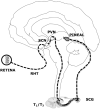A brief review about melatonin, a pineal hormone
- PMID: 30304113
- PMCID: PMC10118741
- DOI: 10.20945/2359-3997000000066
A brief review about melatonin, a pineal hormone
Abstract
Melatonin is a ubiquitous molecule in nature, being locally synthesized in several cells and tissues, besides being a hormone that is centrally produced in the pineal gland of vertebrates, particularly in mammals. Its pineal synthesis is timed by the suprachiasmatic nucleus, that is synchronized to the light-dark cycle via the retinohypothalamic tract, placing melatonin synthesis at night, provided its dark. This unique trait turns melatonin into an internal synchronizer that adequately times the organism's physiology to the daily and seasonal demands. Besides being amphiphilic, melatonin presents specific mechanisms and ways of action devoted to its role as a time-giving agent, being widely spread in the organism. The present review aims to focus on melatonin as a pineal hormone with specific mechanisms and ways of action, besides presenting the clinical syndromes related to its synthesis and/or function disruptions.
Conflict of interest statement
Disclosure: no potential conflict of interest relevant to this article was reported.
Figures





References
-
- Vollrath L. The Pineal Organ. Mollendorff WaB, W., editor. Heildberg, Germany: Springer-Verlag; 1981. p. 659
-
- Kappers JA. The development, topographical relations and innervation of the epiphysis cerebri in the albino rat. Z Zellforsch Mikrosk Anat. 1960;52:163-215. - PubMed
-
- Afeche SC, do Amaral FG, Villela DCM, Abrahão MV, Peres R, Cipolla-Neto J. Melatonin and the Pineal Gland. In: Romano E, De Luca S, editors. New Research on Neurosecretory Systems. New York: Nova Biomedical Books; 2008. p. 151-77.
-
- Reiter RJ. Pineal melatonin: cell biology of its synthesis and of its physiological interactions. Endocr Rev. 1991;12(2):151-80. - PubMed
Publication types
MeSH terms
Substances
LinkOut - more resources
Full Text Sources
